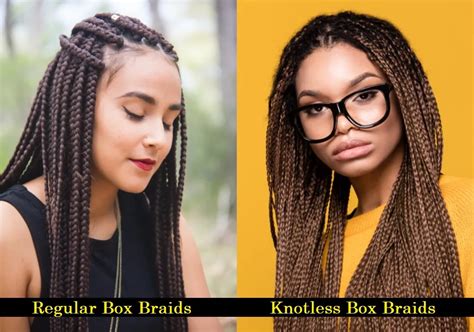Introduction
Protective hairstyles have become increasingly popular in recent years, offering a versatile and stylish way to manage and protect natural hair. Among the most popular protective styles are knotless braids and box braids. Both styles involve braiding hair extensions into natural hair, but they differ in their techniques and overall look. This guide will delve into the key differences, benefits, and drawbacks of knotless braids and box braids, empowering you to make an informed decision about which style is right for you.

Knotless Braids
Knotless braids are a relatively new technique that involves braiding extensions directly into natural hair without using knots. Instead, the braider uses a “feed-in” method, where small sections of natural hair are gradually added to the braid as it progresses. This technique creates a seamless, natural-looking braid that is less likely to cause tension or breakage at the roots.
Box Braids
Box braids are a more traditional braiding technique that involves sectioning hair into square or rectangular “boxes” and braiding extensions into each section. The braids are typically thicker and more defined than knotless braids, and they can be styled in various ways, including buns, ponytails, and updos.
1. Installation Time and Cost
- Knotless braids typically take longer to install than box braids due to the more intricate technique involved.
- The cost of installation for both styles can vary depending on the length, thickness, and complexity of the braids, as well as the skill level of the braider.
2. Comfort and Tension
- Knotless braids are generally considered to be more comfortable to wear than box braids because they involve less tension on the roots.
- The absence of knots eliminates the risk of scalp irritation or hair breakage.
3. Appearance and Versatility
- Knotless braids create a more natural-looking and less bulky appearance than box braids.
- Box braids offer more styling options due to their thicker and more defined nature.
4. Maintenance and Longevity
- Both knotless braids and box braids require regular maintenance, including washing, conditioning, and re-tightening to maintain their appearance and prevent tangling.
- The lifespan of both styles can vary depending on factors such as hair type, styling habits, and maintenance routine, but they typically last for several weeks.
- Reduced tension and scalp irritation
- Seamless and natural-looking appearance
- Less bulky and more lightweight
- Gentle on natural hair, minimizing breakage
- Suitable for all hair types and textures
- Thicker and more defined appearance
- Versatile styling options
- Can be worn for longer periods (up to 8-12 weeks)
- Protective against breakage and damage
- Can add length and volume to hair
- Longer installation time
- May be more expensive to install
- Less styling versatility compared to box braids
- Can be uncomfortable to wear due to tension
- May cause scalp irritation or hair breakage if not installed properly
- More bulky and heavier
- May require more frequent re-tightening
The choice between knotless braids and box braids ultimately depends on your personal preferences, hair type, and desired outcome. If you prioritize comfort, natural appearance, and reduced tension, knotless braids are a suitable option. If you prefer thicker, more defined braids with versatile styling options, box braids may be a better choice.
- Consultation with a professional: Before getting either style, it’s essential to consult with a licensed hairstylist who can assess your hair and recommend the best option for you.
- Hair health: Both knotless braids and box braids can be protective styles, but they can also cause damage if not installed or maintained properly. Ensure your hair is healthy and well-moisturized before braiding.
- Maintenance: Protective braids require regular maintenance to keep them looking their best and prevent damage. Follow your hairstylist’s instructions for washing, conditioning, and re-tightening.
- Styling versatility: While knotless braids offer less styling versatility than box braids, there are still various creative ways to style them, such as accessorizing with beads or ribbons.
- Personal taste: Ultimately, the best protective style is the one that suits your personal taste and hair goals. Consider your lifestyle, preferences, and desired outcome when making your decision.
1. Which style is more painful to install?
Box braids typically cause more tension and discomfort during installation than knotless braids.
2. How often should I wash and re-tighten my braids?
The frequency of washing and re-tightening depends on the style, hair type, and maintenance routine. Consult with your hairstylist for specific recommendations.
3. Can I wear protective braids if I have thin or damaged hair?
Yes, protective braids can be a protective option for thin or damaged hair, as they reduce manipulation and exposure to harsh elements. However, it’s crucial to have your hair assessed by a professional to determine the best style and maintenance plan.
4. How long can I wear protective braids?
The lifespan of protective braids can vary depending on the style, hair type, and maintenance routine. Knotless braids typically last for 4-6 weeks, while box braids can last up to 8-12 weeks.
5. Can I sleep in my braids?
Yes, you can sleep in your braids, but it’s essential to protect them from tangling and breakage. Use a satin pillowcase or wrap your head in a silk scarf before sleeping.
6. Can I use heat on my braids?
It’s generally not recommended to use heat on protective braids, as this can damage the hair and extensions. If necessary, use low heat and avoid direct contact with the hair.
Knotless braids and box braids are both popular protective styles that offer unique benefits and considerations. Understanding the key differences between these styles will empower you to make an informed decision about which option best suits your needs and hair goals. Remember, the best protective style is the one that keeps your natural hair healthy, protected, and looking its best.
